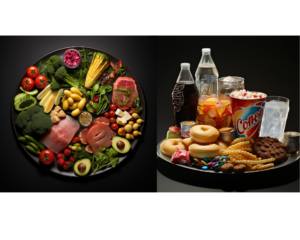
Opportunity + Perseverance = Success
How are grass-fed cows raised?
If you are a beef lover, you may have heard about the benefits of grass-fed beef over grain-fed beef. Grass-fed beef comes from cows that eat mostly grass, while grain-fed beef comes from cows that eat a diet that includes soy, corn, and other additives. Grain-fed cows may also be given antibiotics and growth hormones to fatten them up quickly.
But what does it mean to be grass-fed? How are grass-fed cows raised? And is grass-fed beef really better for your health and the environment?
The difference between grass-fed and grain-fed cattle
In the United States, most cows start their lives in pastures, drinking milk from their mothers and eating grass or other plants they find in their environment. This continues for about 7 to 9 months.
After that, most conventionally raised cows are moved to feedlots and kept in confined stalls with limited space. They are rapidly fattened with grain-based feeds, usually made from soy or corn. Their diet is also supplemented with small amounts of dried grass. The cows live in these feedlots for a few months before being brought to a slaughterhouse.
Grass-fed cows, on the other hand, spend their entire lives grazing on pastures or rangelands. They eat a variety of grasses and other plants, depending on the season and the region. They are not given any grains, antibiotics, or hormones.
However, not all grass-fed beef is the same. There is no legal standard for “grass-fed,” which means that meat producers can freely use it as long as their cattle eat grass at some point. That means the cows might have started eating grass and transitioned to a more conventional grain diet to fatten them before slaughter.
To ensure you get 100% grass-fed beef, look for labels that say “grass-finished” or “grass-fed and grass-finished.” You can also look for certifications from organizations like the American Grassfed Association or the USDA Grass-Fed Program for Small and Very Small Producers.
The benefits of grass-fed beef
Grass-fed beef has several advantages over grain-fed beef for your health and the environment.
Grass-fed beef is lower in calories and fat than grain-fed beef. A 4-ounce serving of raw grass-fed ground beef contains 224 calories and 14 grams of fat, while the same amount of raw grain-fed ground beef contains 280 calories and 22 grams of fat.
Grass-fed beef is also higher in omega-3 fatty acids, essential for brain and heart health. Omega-3s can lower inflammation, blood pressure, and cholesterol levels. Grass-fed beef has up to six times more omega-3s than grain-fed beef.
Grass-fed beef is also richer in antioxidants, such as vitamin E and beta-carotene, which can protect your cells from damage and aging. Grass-fed beef also has more healthy omega-6 fatty acids, which can balance out the omega-3s and support your immune system.
Grass-fed beef is also better for the environment than grain-fed beef. Grass-fed cows produce less greenhouse gas emissions than grain-fed cows because they digest their food more efficiently and produce less methane. Grass-fed cows also help maintain soil quality and biodiversity by fertilizing the land with manure and grazing on different plants.
How to choose and cook grass-fed beef
Grass-fed beef has a different taste and texture than grain-fed beef. It is leaner, firmer, and more flavorful. It also has a darker color and a stronger smell.
Because grass-fed beef is lower in fat, it can dry out faster than grain-fed beef when cooked. To prevent this, you should cook grass-fed beef at a lower temperature and for a shorter time than grain-fed beef. You should also avoid overcooking it, as it can become tough and chewy.
You can use any cooking method for grass-fed beef, such as grilling, roasting, broiling, or frying. However, it would be best if you always used a meat thermometer to check the doneness of your meat. The USDA recommends cooking ground beef to an internal temperature of 160°F (71°C) and steaks and roasts to 145°F (63°C).
Let your grass-fed beef rest for about 10 minutes after cooking to allow the juices to redistribute throughout the meat. This will make it more tender and juicy.
To enhance its flavor, you can season your grass-fed beef with salt, pepper, herbs, spices, or marinades. However, avoid using too much sugar or acidic ingredients in your marinades, which can make the meat tougher.
Grass-fed beef is a healthy and sustainable choice for meat lovers who want to enjoy high-quality beef with less environmental impact. By choosing grass-finished or certified grass-fed beef, you can ensure that you are getting the real deal. By cooking it properly, you can savor its delicious taste and texture.
What are the harmful side effects of eating cows injected with hormones and steroids?
If you are a meat lover, think twice before biting into that juicy burger or steak. Why? Because you could be consuming hormones and steroids that were injected into the cows that produced the meat. This article will explore the harmful side effects of eating cows injected with hormones and steroids and why you should avoid them.
What are hormones and steroids, and why are they used in cows?
Hormones and steroids are substances that regulate the growth, development, and reproduction of animals and humans. The body naturally produces hormones, while steroids are synthetic versions of hormones. Some examples of hormones and steroids used in cows are:
– Bovine somatotropin (bST), also known as bovine growth hormone, is a protein hormone that stimulates milk production in dairy cows. Every 14 days, cows receive an injection of it. It’s made using recombinant DNA technology.
– Estradiol, testosterone, and progesterone are sex hormones that affect the reproductive cycle of cows. They also increase muscle mass and weight gain in beef cattle.
– Zeranol, trenbolone acetate, and melengestrol acetate are synthetic hormones that mimic the effects of natural sex hormones. They are also used to promote growth and feed efficiency in beef cattle.
Farmers use these hormones and steroids to increase the quantity and quality of meat and milk they produce from their cows. This way, they can make more money from their livestock.
Eating cows that have been injected with hormones and steroids can have severe consequences for your health.
Some of the harmful side effects are:
– Hormonal imbalance: Consuming extra hormones from animal products can disrupt the natural hormonal balance in your body. This can lead to various health problems, such as acne, mood swings, weight gain, infertility, breast cancer, prostate cancer, and more.
– Antibiotic resistance: Cows injected with hormones and steroids are more susceptible to infections and diseases. To prevent this, farmers also give them antibiotics. However, this can create antibiotic-resistant bacteria that can be transferred to humans through meat and milk. These bacteria can cause infections that are difficult or impossible to treat with common antibiotics.
– Allergic reactions: Some people may be allergic to the hormones and steroids used in cows. This can cause symptoms such as hives, itching, swelling, breathing difficulties, nausea, vomiting, and more.
How can you avoid eating cows injected with hormones and steroids?
The best way to avoid eating cows injected with hormones and steroids is to choose organic or grass-fed meat and dairy products. These products come from cows that are raised without the use of hormones, steroids, antibiotics, or other drugs. They are also fed a natural grass and hay diet, making them healthier and happier.
Another option is to reduce or eliminate your consumption of meat and dairy products altogether. You can get your protein, calcium, and other nutrients from plant-based sources such as beans, nuts, seeds, tofu, tempeh, soy milk, almond milk, and more. These foods are hormone- and steroid-free, cholesterol-free, and lower in saturated fat.
Eating cows injected with hormones and steroids is not worth the risk to your health. By choosing organic or grass-fed meat and dairy products or opting for plant-based alternatives, you can protect yourself from the harmful side effects of these substances. You can also help the environment by reducing greenhouse gas emissions, water pollution, and land degradation caused by factory farming.
References:
[1] https://www.fda.gov/animal-veterinary/product-safety-information/bovine-somatotropin-bst [2] https://drmichaelwayne.com/blog/the-meat-you-eat-steroid-use-in-livestock/ [3] https://dietsinreview.com/diet_column/08/hormones-in-food-the-good-the-bad-and-the-potentially-dangerous/ [4] https://www.onegreenplanet.org/natural-health/how-dairy-affects-your-hormones/


